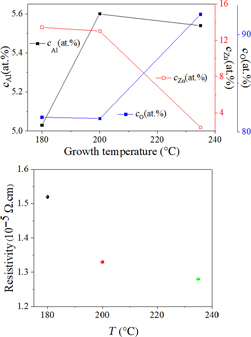Crossref Citations
This article has been cited by the following publications. This list is generated based on data provided by
Crossref.
Zhang, Xianyang
and
Zhu, Rongyang
2020.
Optimization of Al-doped ZnO films by RF magnetron sputtering at room temperature for Cu (In, Ga) Se2 solar cells.
Journal of Physics: Conference Series,
Vol. 1549,
Issue. 4,
p.
042006.
Mohamedi, M.
Challali, F.
Touam, T.
Chelouche, A.
Ouhenia, S.
Souici, A. H.
and
Djouadi, D.
2021.
AZO thin films grown by confocal RF sputtering: role of deposition time on microstructural, optical, luminescence and electronic properties.
Journal of Materials Science: Materials in Electronics,
Vol. 32,
Issue. 20,
p.
25288.
Liu, Hai-Quan
and
Yao, Cheng-Bao
2022.
Composition engineering of AZO films for controlled photon–electron conversion and ultrafast nonlinear optical behavior.
Nanoscale,
Vol. 14,
Issue. 25,
p.
9169.
Güneri, Emine
Göde, Fatma
Çelik, Ali
and
Dere, Ayşegül
2022.
WITHDRAWN: Investigation of the structural, optical bandgap, Urbach's tail, and photoluminescence properties of Mn-doped ZnO thin films.
Solid State Communications,
p.
115047.
Starowicz, Zbigniew
Zięba, Adam
Ostapko, Jakub
Wlazło, Mateusz
Kołodziej, Grzegorz
Jakub Szczerba, Maciej
Putynkowski, Grzegorz
and
Piotr Socha, Robert
2023.
Synthesis and characterization of Al-doped ZnO and Al/F co-doped ZnO thin films prepared by atomic layer deposition.
Materials Science and Engineering: B,
Vol. 292,
Issue. ,
p.
116405.
Göde, F.
and
Balpınar, N.
2023.
Dye-sensitized solar cells fabricated using ZnO:Cu thin films and dye extracted from Hypericum perforatum L. flowers.
Digest Journal of Nanomaterials and Biostructures,
Vol. 18,
Issue. 1,
p.
389.
Çetinel, Alper
and
Burgaz, Sefer Haşim
2024.
The Effect of Concentration of Aluminum on Structural, Optical, and Electrical Properties of Aluminum‐doped ZnO Nanostructures Electrochemically Deposited on Polyimide.
ChemistrySelect,
Vol. 9,
Issue. 32,
